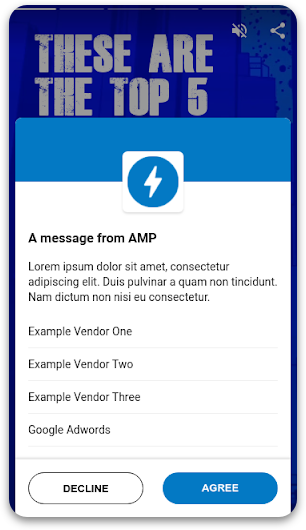Over the past few weeks, we launched tools to help publishers collect user consent. Today, we’d like to give you an update on some new functionality that may make it easier for publishers to collect consent on AMP pages.
Ad Network integrations with the <amp-consent> component
The DoubleClick and AdSense implementations of <amp-ad> now support <amp-consent>, including non-personalized ad serving. See detailed documentation about when and how to serve non-personalized ads from DoubleClick and AdSense and availability here.
Separately, if you are an ads or analytics vendor, you can learn more about how you can integrate with <amp-consent> here.
<amp-ima-video> support for <amp-consent>
Publishers can now collect consent when using the <amp-ima-video> component. See availability date here.
Using <amp-geo> for geolocation-based configuration of <amp-consent>
AMP provides a way to configure <amp-consent> with a remote call by using the checkConsentHref field. If you wished to incorporate geolocation-based logic for <amp-consent>, you would need to resolve geolocation on the server-side, and customize the checkConsentHref response accordingly. Until now, it was not possible to have geolocation-based logic without a remote server setup.
The <amp-geo> component recently launched to enable content variation based on users’ approximate location, at the level of an ISO Country Code. Now, you can use this functionality in combination with <amp-consent>, which also means you could skip implementing checkConsentHref, if your configuration needs do not extend beyond geolocation. Checkout the ampbyexample.com <amp-geo> sample or the <amp-consent> documentation.
<amp-consent> support in AMP stories
Coming soon, <amp-consent> will be available to use with <amp-story>. For the <amp-story> use case only, most of the UI will be pre-configured, though there will be publisher-specifiable choices for the look and feel in addition to full control over the text content. In addition, all <amp-consent> UIs in AMP stories will be blocking (i.e., the consent UI will not have an optional close button). See availability date here.

New features in <amp-consent>
checkConsentHref support for key-value pairs : This feature allows the checkConsentHref endpoint to respond with key-value pairs that can be propagated to and consumed by the ad network implementation. This is useful for publishers who want to communicate additional configuration information to ad networks to serve appropriate ads. This information is available to AMP components that wait on <amp-consent> to resolve. More details here.
Timeouts in <amp-consent> : With this feature, publishers could unblock components waiting for consent after a certain timeout. The feature also allows publishers to configure consent state that would be obtained by the AMP components blocked on the consent. More details here.
Availability
All this functionality is launching at different times in May, 18. Below is a summary of availability and you can go here for the latest updates.
| Functionality | Prod Availability | Documentation | Ready For Testing? |
| DoubleClick & AdSense | 05/10/18 | Link | Yes |
| AMP IMA Video Integration | 05/15/18 | No | |
| AMP Geo | 05/10/18 | Link | Yes |
| AMP Stories | 05/15/18 | No |
What’s next?
There are a number of features planned for <amp-consent> including supporting external consent flows and many others. If you have features in mind that haven’t been discussed yet, please add a comment to the master issue.
Also, don’t forget to check out the amp-consent usage examples on AMP By Example.
As always, thanks for your support. If you have any questions, let us know by opening an issue on GitHub.
Posted by Vamsee Jasti, Product Manager, AMP Project